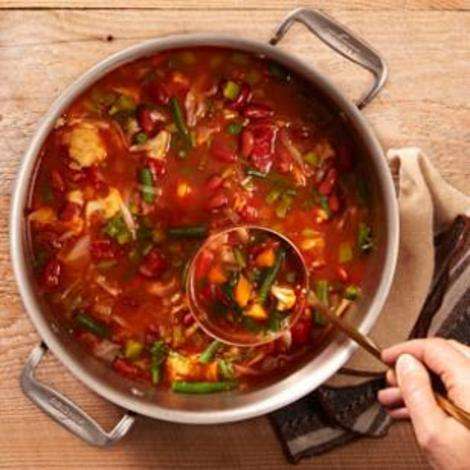Healthy Low-Calorie Foods You Can Eat a Lot Of

Lisa D'Agrosa, M.S., R.D., Associate Nutrition Editor, EatingWell Magazine
There are some days where my stomach feels like a bottomless pit. Usually I try to distract myself by going for a walk, drinking water or chatting with a friend. But sometimes my hunger rages All. Day. Long--no matter what tricks I try (please tell me you can relate). When I know I'm going to be munching more than usual, I try to do the least amount of damage to my diet by choosing foods that are low in calories and satisfy my cravings. That means I reach for foods that take up a lot of space in my tummy for not a lot of calories. I'm not suggesting you throw portion control to the wind--but here are some feel-full options that deliver satisfaction on fewer calories for days when you're feeling hungrier than usual.
1. Popcorn
Popcorn totally satisfies a craving for a salty, crunchy snack. Yum. Foods that are filled with air, like popcorn, trick us into thinking we're eating more, according to Barbara Rolls, Ph.D., author of The Ultimate Volumetrics Diet. As a bonus, popcorn counts as a whole grain. Most of us don't eat enough whole grains, which deliver more fiber than refined grains. Air-popped popcorn is the lowest calorie choice, and be sure to avoid popcorns that claim to be "movie-theater" style, as they tend to be high in calories and sodium.
Don't Miss: Whole-Grain Snacks for 200 Calories or Less
2. Soup
Broth-based soups are "souper"-filling, since water or broth adds volume without adding too many (or any!) calories. That means you get to eat a lot more of it-so go for the black bean soup instead of the refried beans if you want to dish out a larger serving. Plus, according to an Obesity Research study, women who ate low-cal soup twice daily for a year lost 50 percent more weight than women who ate the same number of calories from energy-dense snacks. Try this Veggiestrone soup (a riff on a popular Weight-Watchers recipe), which has only 169 calories in a 2-cup serving.
3. Celery
I love, love, love celery. I probably eat it every day for a snack, but I especially love it as a low-cal standby when I'm feeling ravenous. One large stalk of celery has 10 calories but also provides a gram of fiber-so 10 large stalks would provide 10 grams of fiber for only 100 calories. And eating fiber-rich foods helps you feel full. I love to eat celery plain, with peanut butter, or with olives and cream cheese. Note that celery is on the Environmental Working Group's "Dirty Dozen" list of the foods with the most pesticide residues, so you may want to consider buying organic.
4. Veggie-Packed Meals
Vegetables are generally lower in calories per volume than proteins and grains-so if I want to eat a bigger meal, I jam it full of vegetables. One study found that when women ate either plain rice or rice with added vegetables, those who noshed on the veggie-filled rice downed 41 percent fewer calories and felt more satisfied afterward.
5. Fruit Pops
Frozen-fruit popsicles are great because they help tame your sweet tooth and are generally pretty low in calories. Plus, have you ever tried to eat popsicles too quickly? Brain freeze! This frosty treat forces you to slow down, which helps you take in fewer calories because you feel more satisfied with less food. These Strawberry-Banana Smoothie Pops have less than 100 calories and are made with nutritious real fruit and just a touch of sweetener. Buying popsicles at the store? Look for ones made with real fruit that clock in at 100 calories or less.
6. Carrots
Carrot sticks are slightly sweet and can quell a desire for something crunchy. And at 25 calories per medium carrot, you can eat a lot carrot sticks! If you don't like eating raw carrots, this delicious and super-simple recipe for Sesame Carrots has only 33 calories per serving. So even if you demolish the entire recipe (3 servings), you'll have consumed less than 100 calories.

Lisa D'Agrosa is EatingWell's associate nutrition editor. She earned her master's degree in nutrition communication from the Friedman School of Nutrition Science and Policy at Tufts University and attended the dietetic internship program at Massachusetts General Hospital to become a registered dietitian.
Related Links from EatingWell:
